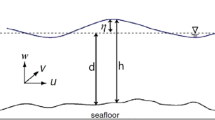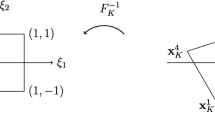Abstract
Stiff wave systems are systems which exhibit a slow dynamical time scale while possessing fast wave phenomena. The physical effects of this fast wave may be important to the system, but resolving the fast time scale may not be required. When simulating such phenomena one would like to use time steps on the order of the dynamical scale for time integration. Historically, Semi-Implicit (SI) methods have been developed to step over the stiff wave time scale in a stable fashion. However, SI methods require some linearization and time splitting, and both of these can produce additional time integration errors. In this paper, the concept of using SI methods as preconditioners to Jacobian-Free Newton-Krylov (JFNK) methods is developed. This algorithmic approach results in an implicitly balanced method (no linearization or time splitting). In this paper, we provide an overview of SI methods in a variety of applications, and a brief background on JFNK methods. We will present details of our new algorithmic approach. Finally, we provide an overview of results coming from problems in geophysical fluid dynamics (GFD) and magnetohydrodynamics (MHD).
Similar content being viewed by others
References
Biskamp, D. (1993).Nonlinear Magnetohydrodynamics. Cambridge University Press, Cambridge.
Biskamp, D. (2000).Magnetic Reconnection in Plasmas. Cambridge University Press, Cambridge.
Brackbill, J. U., and Pracht, W. E. (1973). An implicit, almost-Lagrangian algorithm for magnetohydrodynamics.J. Comput. Phys. 13, 455–482.
Brown, P. N., and Saad, Y. (1990). Hybrid Krylov methods for nonlinear systems of equations.SIAM J. Sci. Stat. Comput. 11, 450–481.
Caramana, E. J. (1991). Derivation of implicit difference schemes by the method of differential approximations.J. Comput. Phys. 96, 484–493.
Chacón, L. and Knoll, D. A. (2003). A 2D high-β Hall MHD implicit nonlinear solver.J. Comput. Phys. 188, 573–592.
Chacón, L., Knoll, D. A., and Finn, J. M. (2002). An implicit nonlinear reduced resistive MHD solver.J. Comput. Phys. 178, 15–36.
Chacón, L., Knoll, D. A., and Finn, J. M. (2003). Hall MHD effects in the 2-D Kelvin-Helmholtz/tearing instability.Phys. Lett. A,308, 187–197.
Chan, T. F., and Jackson, K. R. (1984). Nonlinearly preconditioned Krylov subspace methods for discrete Newton algorithms.SIAM J. Sci. Stat. Comput. 5:533–542.
Dawson, C.N., Klie, H., Wheeler, M.F., and Woodward, C.S. (1997). A parallel, implicit, cell centered method for two-phase flow with a preconditioned Newton-Krylov solver.Comp. Geosciences,1, 215–249.
Dembo, R. et al. (1982). Inexact Newton methods.SIAM J. Numer. Anal. 19, 400–408.
Eisenstat, S. C., and Walker, H. F. (1996). Choosing the forcing terms in an inexact Newton methods.SIAM J. Sci. Comput. 17, 16–32.
Harlow, F. H., and Amsden, A. A. (1971). A numerical fluid dynamical calculation method for all flow speeds.J. Comput. Phys. 8, 197–214.
Harned, D. S., and Kerner, W. (1985). Semi-implicit method for three-dimensional compressible magnetohydrodynamic simulation.J. Comput. Phys. 60, 62–75.
Harned, D. S. and Mikic, Z. (1989). Accurate semi-implicit treatment of the Hall effect in magnetohydrodynamics.J. Comput. Phys. 83, 1–15.
Holton, J. R. (1979).An Introduction to Dynamic Meteorology, Academic Press, Orlando.
Jackson, J. D. (1975).Classical Electrodynamics, Second Edition, Wiley, New York.
Kelley, C. T. (1995).Iterative Methods for Linear and Nonlinear Equations, SIAM, Philadelphia.
Kerkhoven, T., and Saad, Y. (1992). On acceleration methods for coupled nonlinear elliptic systems.Numer. Math. 60, 525–548.
Knoll, D. A., and Chacón, L. (2002). Magnetic reconnection in the two-dimensional Kelvin-Helmholtz instability.Phys. Rev. Lett. 88, (215003).
Knoll, D. A., Chacón, L., Margolin, L. G. and Mousseau, V. A. (2003). On balanced approximations for the time integration of multiple time scale systems.J. Comput. Phys. 185, 583–611.
Knoll, D. A., and Keyes, D. E. (2003). Jacobian-Free Newton-Krylov methods: A survey of approaches and applications.J. Comput. Phys. 193, 357–397.
Knoll, D. A., VanderHeyden, W. B., Mousseau, V. A., and Kothe, D. B. (2002). On preconditioning Newton-Krylov methods in solidifying flow applications.SIAM J. Sci. Comput. 23, 381–397.
Kwizak, M., and Robert, A. J. (1971). Semi-implicit scheme for grid point atmospheric models of the primative equations.Mon. Wea. Rev. 99, 32–36.
Mousseau, V. A., Knoll, D. A. and Rider, W. J. (2000). Physics-based preconditioning and the Newton-Krylov method for non-equilibrium radiation diffusion.J. Comput. Phys. 160, 743–765.
Mousseau, V.A., Knoll, D. A., and Reisner, J. (2002). An implicit nonlinearly consistent method for the two-dimensional shallow-water equations with Coriolis force.Mon. Wea. Rev. 130, 2611–2625.
M. Pernice, and Tocci, M.D. (2001). A multigrid-preconditioned Newton-Krylov method for the incompressible Navier-Stokes equations.SIAM J. Sci. Comput. 23, 398–418.
Reisner, J., Mousseau, V.A., Wyszogrodzki, A. and Knoll, D. A. (2005). An implicitly balanced hurricane model with physics-based preconditioning.Mon. Wea. Rev. 133, 1003–1022.
Reisner, J., Wynne, S., Margolin, L. and Linn, R. (2000). Coupled atmospheric-fire modeling employing the method of averages.Mon. Wea. Rev. 128, 3683–3691.
Reisner, J., Wyszogrodzki, A., Mousseau, V.A., and Knoll, D. A. (2003). An efficient physics-based preconditioner for the fully implicit solution of small-scale thermally driven atmospheric flows.J. Comput. Phys. 189, 30–44.
Saad, Y. (1996).Iterative Methods for Sparse Linear Systems, PWS Publishing Company, Boston.
Author information
Authors and Affiliations
Corresponding author
Rights and permissions
About this article
Cite this article
Knoll, D.A., Mousseau, V.A., Chacón, L. et al. Jacobian-free newton-krylov methods for the accurate time integration of stiff wave systems. J Sci Comput 25, 213–230 (2005). https://doi.org/10.1007/BF02728989
Received:
Accepted:
Issue Date:
DOI: https://doi.org/10.1007/BF02728989




